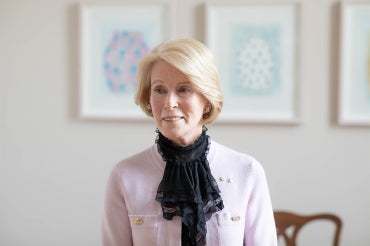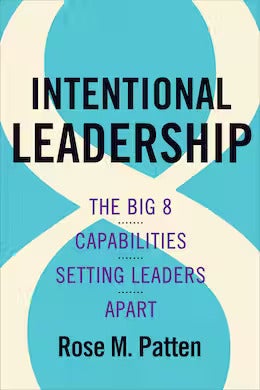Intentional Leadership: Chancellor Rose Patten's new book helps leaders navigate today's challenges

Published: March 1, 2023
University of Toronto Chancellor Rose Patten says there’s one leadership skill that’s served her throughout a career spanning more than three decades, four financial sectors and several continents: the ability to adapt to change.
It’s a quality that Patten says is paramount for today’s leaders as they confront the tumult of global crises, changing demographics and technological revolution – and it’s a central theme in her latest book, Intentional Leadership: The Big 8 Capabilities Setting Leaders Apart.
 To better prepare leaders, Patten writes about “game-changer” trends from which no leader is exempt, identifies which abilities are more highly valued now and in turbulent times, and asks what would compel and enable leaders to be more self-aware and pursue renewal.
To better prepare leaders, Patten writes about “game-changer” trends from which no leader is exempt, identifies which abilities are more highly valued now and in turbulent times, and asks what would compel and enable leaders to be more self-aware and pursue renewal.
In doing so, she draws from her decades of success in Canada’s financial services industry – including senior executive roles at BMO and Manulife – academia and the public sector, as well as her experiences shepherding the next generation of leaders at U of T as co-director of the Executive Leadership Program at the Rotman School of Management and through the creation of the university’s Rose Patten Mentorship Program.
“I believe that everyone has the ability to be a leader, but you have to have willingness,” says Patten, who is an adjunct professor at Rotman. “You have to understand what is most relevant to be effective today, because it’s not the same as yesterday.”
As the pendulum swings away from old-school, top-down power structures in favour of more collaborative leadership models, Patten says there needs to be a greater emphasis on the human side of leading, which she boils down to the “Big 8” capabilities: personal adaptability, strategic agility, self-renewal, certainty of character, contextual communication, spirited collaboration and developing other leaders.
Patten recently spoke to U of T News about how intentional leadership can help leaders learn to adapt to an ever-shifting landscape.
Why did you write this book?
This book was not on my bucket list. My growing passion in leadership came from all the wonderful roles that I've had the opportunity to perform throughout my career – what kind of leadership was effective and what was not.
There’s an idea that once a great leader, always a great leader. That’s a common but flawed opinion. Leadership is not timeless. What got us here won't keep us here because change matters. And change defines leadership. I quickly learned that effective leadership is about what's needed now, not what worked yesterday.
This work started in the aftermath of the financial crisis of 2008 and my efforts intensified following the disruptions of the COVID-19 pandemic.
I began to explore three questions. The first was: What are the game changers happening in our world that no one is exempt from?
The second question became: If these are the game changers, what is it that leaders will have to do differently?
The third question was: How do you compel leaders to change? Some leaders might not think they need to change and others might not know how. Changing habits is hard – leadership is hard – so you need to be very intentional in order to keep up.
What are the three “unmistakable game changers”?
What has really changed is that we were focused more singularly for a long time on the shareholder. But now it’s grown so it’s not just about shareholders, it’s about stakeholders –whether it’s customers, employees, students or some other group. Those stakeholders are looking for what I call “the three Ts” – trust, truth and transparency. There is a big difference now in how leaders have to incorporate this into who they are, what they do and how they lead.
The second one is so apparent it hardly needs explanation: The workforce is changing and that’s changing what’s expected from leaders and how employees want to interact with the organization. The workforce has become more multicultural and more multi-generational. And then the pandemic upended what we knew about the workplace and how we work.
The third one gets a bit more into strategy. Coming from a strategy background, I look back and think about how a strategy would be considered “done” and maybe you’d be safe for five years. Now, your strategy is constantly changing. And what is really underpinning that change is digitalization. Digitalization isn’t going away, so short-lived strategies are here to stay – and this will only become more complex.
How has the leadership pendulum shifted?
We have in our mind a certain model of leadership – often called “command and control” – that was considered most effective in decades past. In this model, being a great leader meant being tough, being unflinching, being quite hierarchical. I would call it a very vertical approach.
Now, what we see with all the change coming from the expectations in the workplace is people are looking to leaders for more accessibility. They’re looking to engage with you.
It goes two ways: You're the leader and so you're connecting more with employees a bit down the line – and you’re also utilizing that for your own decision-making. Leaders don’t have all the answers, no matter how smart you are. You want to utilize all the knowledge that’s available to you and that means getting the best talent and engaging them.
I think we’re shifting from “command and control” to “connect and collaborate,” from instinctive leadership to reflection and intention.
What are the “Big 8” leadership capabilities?
The real driver of the “Big 8” is that they’re all very entwined with how you deal with people. The human side of leading is on the rise, whereas in the past it’s been given less attention in how leaders are assessed or even chosen.
The first three are centred around mindset: personal adaptability, strategic agility and self-renewal. It’s about having an open mind, being willing to change it and being self-aware about how you could do better.
Then we move on to personal values. One is empathy, which is about how you relate to others. The next one I call certainty of character: It’s about who you are, what you stand for and how you act on that.
The next three relate to connecting with others. First, there’s contextual communication - today’s workforces want to understand “the why” of decisions and changes and we need to respect and utilize the value they can add. Then, there’s spirited collaboration: People think of collaboration as creating harmony, but sometimes to get the best outcome you need to allow for a bit of spirited dissent. The very last one is about developing others because, at the end of the day, the mark of a good leader is not what they’ve personally achieved, but how they’ve led people who can achieve and be their best.
I see leaders as being obligated to develop very capable people to become heroes. Then the team becomes the hero and the leader is the navigator.
How do you think this book could empower new kinds of leaders?
They call it “Rose’s mantra” – I didn’t name it myself – but I have a statement that leadership happens when, by intention or not, someone has a positive impact on someone else through inspiration, through wisdom or through empathy. That, to me, describes leadership in its broadest sense. And I believe that that's what this book can do. It's not targeted. I'm multi-sectoral and I'm across every phase of what leadership is. It's universal in this sense. Anybody can be a leader if they have the will and the fortitude.



